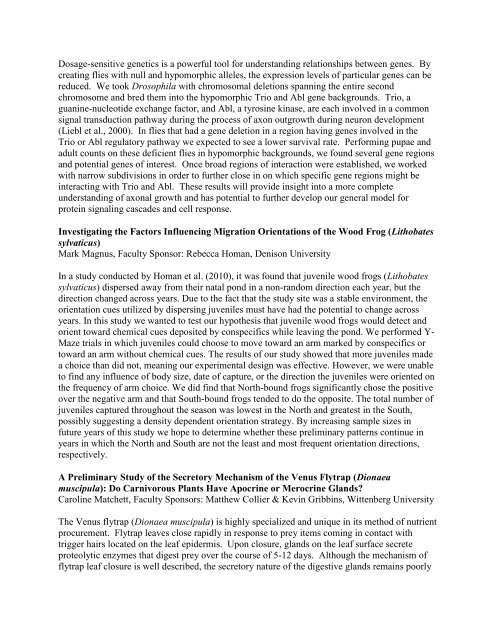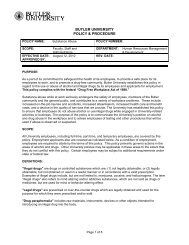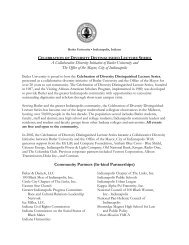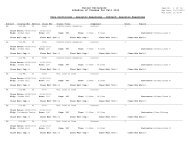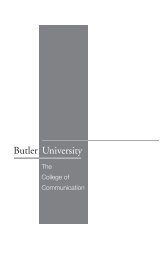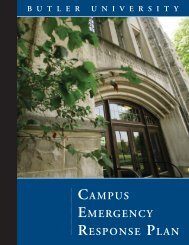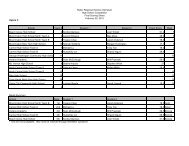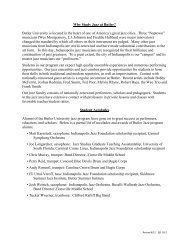Anthropology - Butler University
Anthropology - Butler University
Anthropology - Butler University
Create successful ePaper yourself
Turn your PDF publications into a flip-book with our unique Google optimized e-Paper software.
Dosage-sensitive genetics is a powerful tool for understanding relationships between genes. By<br />
creating flies with null and hypomorphic alleles, the expression levels of particular genes can be<br />
reduced. We took Drosophila with chromosomal deletions spanning the entire second<br />
chromosome and bred them into the hypomorphic Trio and Abl gene backgrounds. Trio, a<br />
guanine-nucleotide exchange factor, and Abl, a tyrosine kinase, are each involved in a common<br />
signal transduction pathway during the process of axon outgrowth during neuron development<br />
(Liebl et al., 2000). In flies that had a gene deletion in a region having genes involved in the<br />
Trio or Abl regulatory pathway we expected to see a lower survival rate. Performing pupae and<br />
adult counts on these deficient flies in hypomorphic backgrounds, we found several gene regions<br />
and potential genes of interest. Once broad regions of interaction were established, we worked<br />
with narrow subdivisions in order to further close in on which specific gene regions might be<br />
interacting with Trio and Abl. These results will provide insight into a more complete<br />
understanding of axonal growth and has potential to further develop our general model for<br />
protein signaling cascades and cell response.<br />
Investigating the Factors Influencing Migration Orientations of the Wood Frog (Lithobates<br />
sylvaticus)<br />
Mark Magnus, Faculty Sponsor: Rebecca Homan, Denison <strong>University</strong><br />
In a study conducted by Homan et al. (2010), it was found that juvenile wood frogs (Lithobates<br />
sylvaticus) dispersed away from their natal pond in a non-random direction each year, but the<br />
direction changed across years. Due to the fact that the study site was a stable environment, the<br />
orientation cues utilized by dispersing juveniles must have had the potential to change across<br />
years. In this study we wanted to test our hypothesis that juvenile wood frogs would detect and<br />
orient toward chemical cues deposited by conspecifics while leaving the pond. We performed Y-<br />
Maze trials in which juveniles could choose to move toward an arm marked by conspecifics or<br />
toward an arm without chemical cues. The results of our study showed that more juveniles made<br />
a choice than did not, meaning our experimental design was effective. However, we were unable<br />
to find any influence of body size, date of capture, or the direction the juveniles were oriented on<br />
the frequency of arm choice. We did find that North-bound frogs significantly chose the positive<br />
over the negative arm and that South-bound frogs tended to do the opposite. The total number of<br />
juveniles captured throughout the season was lowest in the North and greatest in the South,<br />
possibly suggesting a density dependent orientation strategy. By increasing sample sizes in<br />
future years of this study we hope to determine whether these preliminary patterns continue in<br />
years in which the North and South are not the least and most frequent orientation directions,<br />
respectively.<br />
A Preliminary Study of the Secretory Mechanism of the Venus Flytrap (Dionaea<br />
muscipula): Do Carnivorous Plants Have Apocrine or Merocrine Glands?<br />
Caroline Matchett, Faculty Sponsors: Matthew Collier & Kevin Gribbins, Wittenberg <strong>University</strong><br />
The Venus flytrap (Dionaea muscipula) is highly specialized and unique in its method of nutrient<br />
procurement. Flytrap leaves close rapidly in response to prey items coming in contact with<br />
trigger hairs located on the leaf epidermis. Upon closure, glands on the leaf surface secrete<br />
proteolytic enzymes that digest prey over the course of 5-12 days. Although the mechanism of<br />
flytrap leaf closure is well described, the secretory nature of the digestive glands remains poorly


